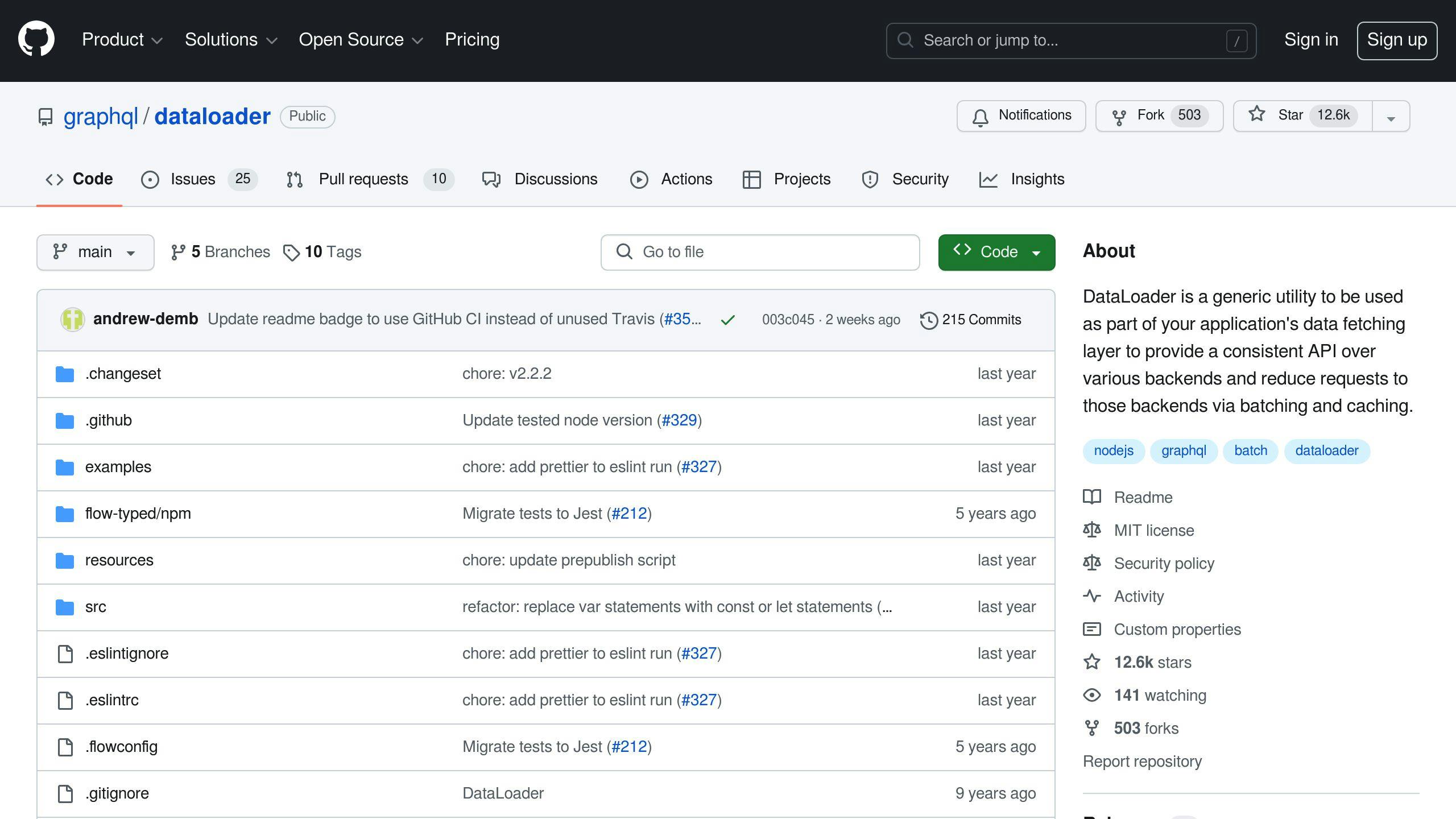


Learn best practices for GraphQL field resolvers, including performance tips, error handling, and organizing resolvers. Understand how resolvers work and the impact on performance.
If you're diving into GraphQL, understanding how field resolvers work is key to building efficient, scalable APIs. Here's a quick guide to get you started:
- GraphQL Resolvers act as the bridge between your GraphQL schema and the data stored in your database, fetching the exact data requested by a query.
- Field Resolver Basics: A field resolver is a function that resolves a value for a type or field in a schema. It receives four arguments:
parent,args,context, andinfo. - Performance Tips: Use tools like DataLoader for batching and caching strategies to reduce database load.
- Error Handling: Implement custom GraphQL errors and log server-side errors for debugging, while keeping client-side messages user-friendly.
- Organizing Resolvers: Keep your codebase manageable by grouping resolvers by type or co-locating them with type definitions.
- Business Logic: Keep complex business logic out of resolvers to maintain clarity and simplicity.
- Monitoring: Use tools like Apollo Studio to monitor resolver performance and optimize as needed.
This guide aims to make these concepts clear and actionable, covering everything from defining resolver functions to error handling and performance optimization. Whether you're setting up resolvers, testing their output, or looking to improve their efficiency, these best practices will help you build a robust GraphQL backend.
Understanding GraphQL Resolvers
Think of a GraphQL resolver as a helper that grabs the data you need for a certain part of a query. When you ask for specific data, like a user's name and age, the resolver first gets the user info, then grabs the name and age details. It's like following a map where each stop gives you a piece of the overall picture you're trying to build.
The Impact of Resolvers on Performance
With GraphQL, you can ask for exactly what you need, which means you don't end up grabbing unnecessary data. This is a big deal because it means your app can run faster since it's not bogged down by extra info it doesn't need. In older REST APIs, you often get a lot of data you didn't ask for, which can make things slower. By using resolvers to only get the data that's needed, everything runs more smoothly and quickly.
What is a GraphQL Field Resolver?
A GraphQL field resolver is basically a function that figures out what data you get when you ask for a specific piece of information in a GraphQL query. Imagine you're asking a GraphQL server for some info; this server then uses resolver functions to go and fetch the data you requested from wherever it's stored.
The resolver function gets four pieces of information to work with:
fieldName(parent, args, context, info) {}
parent: This is the data that came from the previous step. If this is the first step, it's called therootValue.args: These are the details you specify in your query, like asking for a user by their ID.context: This is shared info for all the resolvers to use during a request. It can include things like user login details or how to connect to your database.info: This gives more details about the query, like what part of the query you're dealing with.
Resolver Function Arguments
These four bits of info given to every resolver are super important:
parent - The result from the last step. It helps link together different parts of your data based on your query.
args - The specific details you asked for in your query, like a user's ID.
context - A shared space for all resolvers during a request. It's used for keeping track of things like who's asking for data and where to get it from.
info - This tells you more about the query itself, helping the resolver understand more about what data to fetch.
Resolver Return Values
Resolvers need to give back data that fits what your schema says. For simple things, this is straightforward (like returning a string for an ID), but for more complex data, it means the resolver will hand off to other resolvers to get all the details, step by step.
For instance, if you're asking for a User, the resolver gives back a basic User object. Then, other resolvers take over to fill in more details like the user's address or phone number, bit by bit.
Implementing GraphQL Field Resolvers
Defining Resolver Functions
To make GraphQL resolvers work, we need to set up functions for each piece of data we want to handle. Here's how you might set up resolvers for a user's name and age:
const resolvers = {
User: {
name(parent) {
return parent.firstName + ' ' + parent.lastName;
},
age(parent) {
const birthDate = new Date(parent.birthDate);
const ageDiffMs = Date.now() - birthDate.getTime();
const ageDate = new Date(ageDiffMs);
return Math.abs(ageDate.getUTCFullYear() - 1970);
}
}
}
In these functions, the parent object is used to find and return the data for each field. This is where we can fetch or change data before giving it back.
Adding Resolvers to Apollo Server
Next, we need to connect our resolvers to the Apollo Server like this:
const server = new ApolloServer({
typeDefs,
resolvers
});
Now, whenever someone asks for User data, the right resolver functions will get called to provide the information.
Testing Field Resolvers
We can check if our resolvers are doing their job by asking for data and seeing what we get back:
query {
user(id: "1") {
name
age
}
}
If the answer includes the correct name and age, then our resolvers are set up right! We should test all our resolver functions this way.
Resolver Function Organization
When you're setting up your GraphQL resolvers, it's important to keep things organized so you can find and manage your code easily, especially as your project gets bigger. There are two main ways to do this: either group all the resolver functions for a particular type together or place them right next to where you define what that type looks like.
Grouping by Type
One way to organize is to put all the functions that deal with a certain type, like a User, into one file. So, you might have a userResolvers.js file that looks something like this:
export default {
id: (parent) => parent.id,
name: (parent) => `${parent.firstName} ${parent.lastName}`,
age: (parent) => calculateAge(parent.birthDate),
// etc
};
Pros:
- All the functions for a type are in one spot
- Keeps things tidy and focused
Cons:
- Can get cluttered if you have a lot of types
- The functions are a bit removed from where the type is defined
Co-locating Resolvers
Another approach is to place the resolver functions right next to the definitions of the types they relate to. This could look like:
// User.ts
export type User = {
id: ID
name: String
age: Int
// etc
};
export const UserResolvers = {
id: (parent) => parent.id,
name: (parent) => `${parent.firstName} ${parent.lastName}`,
age: (parent) => calculateAge(parent.birthDate),
}
Pros:
- The logic for each function is right next to its type definition
- Makes it clear where to go if you need to change something
Cons:
- You end up with more files to look after
- Harder to see all your resolvers at once
In the end, whether you group functions by type or put them next to their definitions depends on what makes more sense for you and your team. Both ways have their ups and downs, so think about what will work best for your project.
Efficient Data Fetching in Resolvers
Batching with DataLoader

DataLoader is a tool that helps group together and remember data requests in GraphQL resolvers. This means, instead of asking the database or other data sources for each piece of data one by one, DataLoader can ask for lots of data all at once.
For instance, if you want to show a list of users and their posts, without DataLoader, you might need to ask for users first and then ask again for each user's posts. This could end up being a lot of separate questions. DataLoader, however, lets you ask all these questions in just one or two big asks, which is much faster.
Here's how you might set it up:
const batchUsers = async (keys) => {
const users = await db.users.find({
where: { id: keys }
});
return keys.map(key => [key, users.find(x => x.id===key)]);
}
const userLoader = new DataLoader(batchUsers);
And then in your resolver, you use DataLoader like this:
const userResolver = async (parent, args, context) => {
return userLoader.load(args.id);
}
Caching Resolver Results
Caching means keeping a copy of data so you don't have to ask for it again every time. This makes things faster because your system can skip asking for data it already knows about.
You can use tools like Memcached or Redis for caching. You create a special key based on what you're asking for, so the system knows when to use the saved data and when to get fresh data:
const cache = new RedisCache();
const userResolver = async (parent, args, context) => {
const key = JSON.stringify({ id: args.id });
let user = await cache.get(key);
if (!user) {
user = await db.user.findById(args.id);
await cache.set(key, user, 3600);
}
return user;
}
By keeping data saved for a while, your system doesn't have to keep asking for it, which means things can run faster and smoother.
sbb-itb-bfaad5b
Error Handling in Resolvers
Custom GraphQL Errors
When something goes wrong in GraphQL resolvers, it's key to tell the client what happened in a clear way. Instead of just throwing a basic error, we can make custom GraphQL errors. These can explain the problem better.
For instance, if we can't find a user, we might do this:
throw new GraphQLError('User not found', {
extensions: {
code: 'USER_NOT_FOUND',
},
});
This way, the client gets a straightforward message saying the user wasn't found, along with a specific error code.
Why this is good:
- It makes errors clear for people using the API
- Provides error codes that make troubleshooting easier
- Keeps the messy details hidden
Handling errors this way makes the API nicer to use.
Logging Resolver Errors
Even though we make errors clear for clients, we still need to keep track of them on the server. This helps us figure out and fix backend problems.
A good way to do this is with a logging tool like Winston. You can set up a way to log details whenever there's an error in a resolver:
const logger = createLogger();
const userResolver = async (parent, args, context) => {
try {
// Fetch user logic
} catch (error) {
logger.error('Error getting user', {
error,
parent,
args
});
throw error;
}
}
This logs useful info for fixing bugs without showing those details to the client.
Masking Implementation Details
Resolvers connect your GraphQL API to your data sources, like databases or other services. It's a good idea for resolvers to hide these details from users.
Here's a basic way you might connect to a database in a resolver:
const db = new Database();
const userResolver = async (parent, args, context) => {
return await db.users.findById(args.id);
}
But if there's a problem with the database, we don't want to tell the API users about it. Instead, we catch the error and handle it nicely:
const db = new Database();
const userResolver = async (parent, args, context) => {
try {
return await db.users.findById(args.id);
} catch (error) {
logger.error(error);
throw new DatabaseConnectionError();
}
}
This way, users don't need to know about the backend details. They just get a simple error message. This approach also makes it easier to make changes later without affecting the users.
Monitoring and Analyzing Resolver Performance
Using Apollo Studio
Apollo Studio helps you keep an eye on how fast your resolvers are working. It tracks the time it takes for each resolver to do its job whenever someone makes a request.
Here’s what Apollo Studio shows you:
- Average resolver duration - Tells you if a resolver is slower than it should be.
- 95th/99th percentile durations - Helps you spot very slow responses that might signal a problem.
- Requests over time - Lets you see trends and how changes affect resolver speed.
- Errors - Points out which resolvers are having issues so you can fix them.
With this info, you can find and fix slow parts in your system. Maybe you need to get data more efficiently, use caching better, or tweak other things.
Logging Resolver Timings
Besides what Apollo Studio offers, you can also keep track of how long resolvers take by adding your own timing logs.
Here’s a simple way to do it:
const userResolver = async (parent, args, context) => {
const start = Date.now();
try {
// Resolver logic
} catch(err) {
// Handle errors
} finally {
const end = Date.now();
logger.info(`User resolver took ${end - start} ms`);
}
}
By doing this for each resolver, you can watch how long they take and get alerts if any take too long.
Important things to log:
- Duration - How long the resolver took.
- Field name - Which resolver it was.
- Parent type - Helps you know where in the schema the resolver fits.
- Arguments - Shows if certain inputs make things slower.
With good logging, you get a clear picture of how your resolvers are doing. This helps you spot where to make things faster and check if your fixes are working.
Encapsulating Business Logic in Resolvers
GraphQL resolvers are the bridge between your GraphQL setup and where your data lives. It might be tempting to stuff a bunch of business rules right into these resolvers. But, it's smarter to keep these resolvers simple by putting complex business logic somewhere else.
Guidelines for Business Logic Location
When deciding where to put your business logic for GraphQL resolvers, here are some tips:
- Simple data fetching/manipulation - It's okay to handle easy data tasks directly in resolvers, like getting data from different places, filtering, or changing it a bit.
- Complex business rules - For more complicated rules or core business stuff, put them in separate spots. Then, just call these from your resolvers.
- Shared logic - If you find yourself using the same logic in many resolvers, make reusable bits that resolvers can use.
- Third party services - If you're connecting to other services, wrap this up in its own module or class.
The main idea is to keep resolvers focused on their main job - getting and lightly tweaking data. Leave the heavy lifting to other parts of your code that handle specific business tasks.
Avoiding Resolver Code Bloat
As your GraphQL API grows, so can the amount of code in your resolvers. Here's how to keep them clean:
- Extract logic early - If a resolver starts to get crowded, move stuff out sooner rather than later.
- Create meaningful abstractions - Don't just shuffle code around. Organize it into services that make sense for your business.
- Reuse common logic - If you spot the same logic in different places, pull it out into shared helpers.
- Apply consistency - Have a clear pattern for how resolvers should be built. This helps everyone know where to put what.
Keeping your resolvers tidy helps with keeping things easy to manage as your project grows. Start with clear rules for where to put your logic, and stick to them.
Conclusion
GraphQL resolvers are super important for getting the right data quickly and making sure your API works well. By organizing them well, using smart tricks like caching, handling mistakes properly, and keeping things simple, developers can make sure they only grab the data they need, deal with errors smoothly, and keep the complicated stuff out of the way.
Here's a quick summary of what we've covered:
- Keep resolvers well-organized - Whether you group them by type or put them next to related code, make sure they're easy to find and understand. Keep each function doing just one thing.
- Use smart data fetching tricks - Tools like DataLoader and Redis can help you ask your database for data less often.
- Be smart about errors - Make sure you tell your users about errors in a way that's helpful, but keep the technical details to yourself.
- Watch how your resolvers are doing - Use tools like Apollo Studio and your own logs to make sure your resolvers are fast and efficient.
- Keep the complicated stuff elsewhere - Don't let your resolvers get too complex. Put the heavy-duty logic in separate parts of your code.
Making great GraphQL resolvers helps your server or API answer requests faster, deal with more users, and adapt as things change. With some careful planning and these tips, developers can create strong backends ready for real-world use.
While it might take some effort to get your resolvers just right, the benefits are worth it. You'll be able to handle queries more quickly, manage traffic better, and keep your API flexible for the future. By following these guidelines, you can build a GraphQL backend that's all set for the big time.
Related Questions
What is the resolver for each field in GraphQL?
In GraphQL, every field in the types you define gets a function that knows how to get the data for that field. This function is called a resolver. When someone asks for data, GraphQL calls the resolver for each field requested. If the field is a basic type like a string or number, the resolver's job is done once it provides that value.
What is the biggest disadvantage from using GraphQL?
For small or simple apps that always use data in the same way, adding GraphQL can make things more complicated. This is because you have to deal with setting up types, writing queries and mutations, and managing resolvers, which might be more than you need for a simple project.
Why do we need resolvers in GraphQL?
Resolvers are essential in GraphQL because they're the ones that connect your schema's types and fields to the actual data. Whether you're fetching data with queries, updating data with mutations, or using subscriptions, resolvers work in the background to get or change the data as needed.
Why is GraphQL bad at caching?
Caching is tricky with GraphQL because it uses the POST method for queries, which doesn't have unique URLs like in RESTful APIs. This means it's harder to identify and store responses for quick retrieval later, making caching a challenge.

.png)








